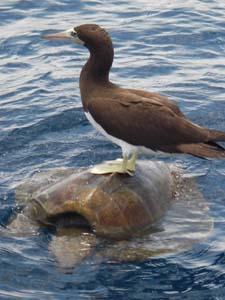Pictures from Drake Bay
It’s one of the world’s prime whale-watching spots, the only place in the world that’s a migration destination for both northern and southern humpbacks, the former coming down from California and Oregon in December-May and the latter from near the Antarctic during our summer and fall. Large pods of pantropical spotted dolphins can also be found here, as well as orcas and pseudo-orcas that scare the dolphins away.
This is mating season for the southern humpbacks and it’s nursing season for both the humpbacks and the dolphins.
We went out three times in motorboats and saw small groups of dolphins, about half a dozen at a time, often with calves. We heard of large pods out beyond the bay, and went there seeking them, but they may have been chased off by the orcas which we also heard were in the area.
Much better luck with the humpbacks. Right in the bay, near Caño Island which is a few miles offshore, we saw a couple of mother-calf pairs at separate times. More spectacularly, we saw groups consisting of one mother-calf pair and anywhere from two to four males competing for the female’s attention. Humpback whale competition consists of displays of splashing and breeching. Which male gets to mate with the female can be literally a matter of which one makes the biggest splash. Males also try to block each other’s access to the female, and sometimes they jump over each other. We saw one breech completely out of the water two or three times, which is apparently a relatively uncommon sight. It was breathtaking, but unfortunately we don’t have decent photos of it, because the action is too fast for an amateur’s off-the-rack digital camera to catch.
We did get pictures of a much slower phenomenon: an aged Olive Ridley sea turtle idling along in the current, with a flock of brown boobies flying around it and landing not only near it but actually on top of its shell. The boobies were hunting for the small pilot fish that travel everywhere underneath the turtle, keeping its underside clean. We couldn’t resist jumping into the water with our snorkel gear and swimming around with the turtle, even touching it – which you’re not supposed to do.
The snorkeling in the shallows off Caño Island was terrific: many varieties of multicolored fish, sometimes in schools of twenty to one hundred. Some small yellow ones with black stripes traveling in a school; foot-long blue-green ones traveling alone; dusty green ones with white spots; inch-long ones of saturated blue, which were the juvenile stage of a fish that looked much grayer and plainer when it grew up; the “golden phase” of yet another fish that matured into plainness… I wish I knew the names of all the varieties. The water was usually ten to twenty feet deep and we snorkeled around encrusted rocks among which fish were hiding. Someone saw a ray. And our friend Mark from London, making one last dive before we departed, saw a tiger shark, five or six feet long, resting at the bottom. Mark also made a spectacular underwater catch when Agent 61’s camera fell off her wrist, swiftly intersecting the camera’s fall at the perfect oblique angle. And the man never even played baseball!
Here are some of the picture Agent 61 (code name: Susan) took with her underwater digital Pentax:

Olive Ridley sea turtle with brown booby topping

Underside of same turtle – the little flake-shaped things are its pilot fish

Agent 95 in the Pacific

Frogman 97, US Navy: note turtle’s fin near his right hand
This is mating season for the southern humpbacks and it’s nursing season for both the humpbacks and the dolphins.
We went out three times in motorboats and saw small groups of dolphins, about half a dozen at a time, often with calves. We heard of large pods out beyond the bay, and went there seeking them, but they may have been chased off by the orcas which we also heard were in the area.
Much better luck with the humpbacks. Right in the bay, near Caño Island which is a few miles offshore, we saw a couple of mother-calf pairs at separate times. More spectacularly, we saw groups consisting of one mother-calf pair and anywhere from two to four males competing for the female’s attention. Humpback whale competition consists of displays of splashing and breeching. Which male gets to mate with the female can be literally a matter of which one makes the biggest splash. Males also try to block each other’s access to the female, and sometimes they jump over each other. We saw one breech completely out of the water two or three times, which is apparently a relatively uncommon sight. It was breathtaking, but unfortunately we don’t have decent photos of it, because the action is too fast for an amateur’s off-the-rack digital camera to catch.
We did get pictures of a much slower phenomenon: an aged Olive Ridley sea turtle idling along in the current, with a flock of brown boobies flying around it and landing not only near it but actually on top of its shell. The boobies were hunting for the small pilot fish that travel everywhere underneath the turtle, keeping its underside clean. We couldn’t resist jumping into the water with our snorkel gear and swimming around with the turtle, even touching it – which you’re not supposed to do.
The snorkeling in the shallows off Caño Island was terrific: many varieties of multicolored fish, sometimes in schools of twenty to one hundred. Some small yellow ones with black stripes traveling in a school; foot-long blue-green ones traveling alone; dusty green ones with white spots; inch-long ones of saturated blue, which were the juvenile stage of a fish that looked much grayer and plainer when it grew up; the “golden phase” of yet another fish that matured into plainness… I wish I knew the names of all the varieties. The water was usually ten to twenty feet deep and we snorkeled around encrusted rocks among which fish were hiding. Someone saw a ray. And our friend Mark from London, making one last dive before we departed, saw a tiger shark, five or six feet long, resting at the bottom. Mark also made a spectacular underwater catch when Agent 61’s camera fell off her wrist, swiftly intersecting the camera’s fall at the perfect oblique angle. And the man never even played baseball!
Here are some of the picture Agent 61 (code name: Susan) took with her underwater digital Pentax:

Olive Ridley sea turtle with brown booby topping

Underside of same turtle – the little flake-shaped things are its pilot fish

Agent 95 in the Pacific

Frogman 97, US Navy: note turtle’s fin near his right hand



<< Home